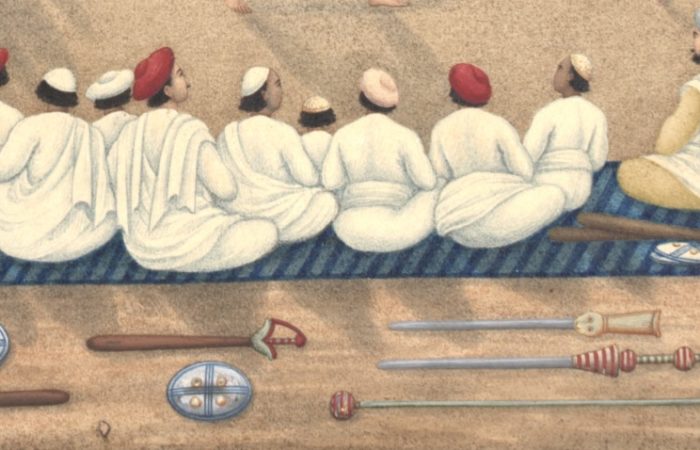Indian modern martial arts with weapons are a mix, or rather, remnants of real swordsmanship, sports and entertainment exercises and a standard set of techniques for demonstration performances. It is important to emphasize that all these elements simultaneously existed in historical reality, represented a single system of warrior training and did not contradict, but complemented each other.
The use of weapons in battle, or at least cutting clay, reinforced real skills and eliminated impractical ones. Sports exercises, such as training matches using a short stick and shield, were designed to practice combinatorial actions, movements and interaction with the opponent. Demonstration techniques occupied, rather, the niche of “warrior dance” and were derived from real skills, and not vice versa. After the prohibitive measures of the British administration, this balance was upset. Moreover, in the first half of the 20th century, against the background, on the one hand, of growing interest in physical culture in general, and on the other hand, in the wake of growing interest in traditional practices, but in the absence of requirements for their real applicability, some adjustments were deliberately made to martial arts, and some arts were even practically recreated anew, precisely taking into account the spectacular side.
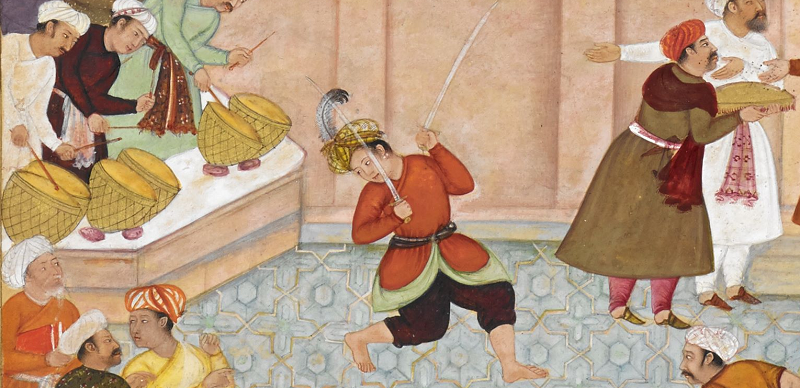
Today, a significant part of martial arts techniques are only demonstration exercises that have developed and established themselves as such without any counterbalance or restraint from other components of the once unified system. Taking into account their simplicity and accessibility, and the fact that such techniques do not require practical testing, with the exception of participation in the show itself, these exercises are fully mastered in adolescence, after which practitioners usually lose interest in further training and development of their skills. The real practical techniques of martial arts remain hidden in boring and unattractive preparatory exercises and therefore are not in demand. Moreover, the principles originally laid down in basic traditional exercises that are necessary for the use of real weapons, such as the habit of maintaining a 90-degree angle between the weapon and the forearm, the forearm and the shoulder, are discarded as superfluous and redundant.
Basic exercises aimed at preparing the body, joints, holding weapons correctly, mastering basic trajectories, steps and movements, which require a lot of time and effort, were not spectacular. On the contrary, the exercises for the show, which did not require deep and complex traditional training, were easy to master and, in the eyes of the audience, significantly surpassed basic training from an entertainment point of view. To learn the art of «fire performance», you do not need to spend years of your life and you do not need knowledge of thousands of years of practice in owning real weapons. There is nothing wrong with a show with weapons, but with absolute dominance and complete separation from the test of practice, such a show begins to represent a separate, different kind of art, the rapid mastery of which requires skills that are often the opposite of the skills of real weapons fighting. As a result, any attempt to present the martial arts of India’s past as derivative of existing demonstration techniques is moot.
Another factor is absolutization of using exercises originally intended to develop basic coordination skills and familiarization with weapons. Previously, these exercises acquired meaning and content in real conditions: cutting with weapons, non-theatrical training matches and the real situation on the battlefield. Instead, these exercises were absolutized, divorced from reality and the practical side, which remained hidden to the student, and were subsequently passed on from mentor to student as main skills. Without further development and application to real situations, these skills began to be perceived as tradition itself and directly military skills.
Main features of exercises for the show:
- Using the lightest weapons
- Excessive weapon rotation speed
- Lack of footwork and movement
- Relaxed wrists
- No force is used
- Lack of control over the edge of talwar/spear/dagger blades
Using the lightest weapons
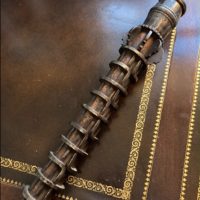
A true historical martial art always involves the use of force, and the principles on which Indian martial arts are based are designed specifically to use the maximum possible force. Strength is necessary both for a drawing blow, in which the saber does not fly by inertia, but rather is pressed into the target, and for blows with a heavy spear, both thrusting and cutting, and even for the use of an iron-bound staff, which does not fly at random, but is controlled along the entire trajectory of movement and is connected to the body.
A person moving with a weapon represents one single closed system, consisting of two physical bodies: the person’s body and his weapon. When a person with a weapon applies force to an external object, another closed system is created, also consisting of two physical bodies, but the person with a weapon is one body and the external target (the enemy) is another body. In the latter case, in order for you to hit the target without losing balance, without falling, without dropping your weapon, etc., you must compensate not only your inertia, but also external influences from your target, conditionally — counterforce. The same is true in the first case for the system consisting of “your body plus your weapon”, when you apply force to rotate or brandishing a heavy object (weapon) that has a certain mass, you are forced to constantly compensate for its impulse, to balance it with your body.
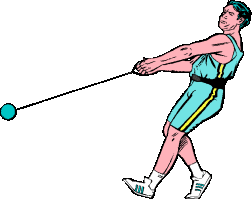
In other words, when learning to wield any weapon, you do not learn to swing it beautifully or effectively, but learn to interact with it, balance, and create a unified system. In such a situation, the weapon is not your saber and not your body, but the saber plus the body together as a single weapon. If the weight of a weapon tends to a minimum and no effort is required to wield it, then it will not be possible to create any system: a separate body will take a separate stick and hit another separate body with it. The same applies to wield of heavy weapons, but without creating a single balanced system: brandishing a large iron pole from side to side may be very practical, but it is not be any art.
The weapon you move has momentum equal to its mass multiplied by its speed. To create a balanced system in which all impulses are compensated in such a way that this system (you plus your weapon) is able to move freely in any direction without losing balance due to inertia, and perform a variety of conscious actions, you will either have to spend years of intense training, or simply reduce one of the multipliers — mass or speed — to the minimum value. In this case, the choice is not great: take the lightest possible object, but with the ability to rotate it very quickly, or take a heavy object and swing it monotonously, standing in one place so as not to fall, or without swinging it anymore run with it, mostly in a straight line, after the enemy running away from you. Moreover, we have not started talking yet about applying force to an external object and thus creating a second system: you with your weapon against the target.
Excessive weapon rotation speed
The most popular exercise, which is designed to impress, demonstrate weapon skills and is the easiest to learn, is quickly spinning the weapon while standing still. It would make sense to add some footwork to this exercise, but it does not because your legs simply physically cannot keep up that kind of rotational speed: you can’t move faster than your feet can step. It is for this reason that all such exercises are performed standing in one place on two legs, often widely spaced, so as not to fall even from the weak inertia created by a light weapon.
In addition, such exercises have no practical meaning. These high-speed rotational movements in themselves do not pose any offensive threat and are not defensive in nature. Unfortunately, they do not parry arrows either. Moreover, in order to strike or defend, you will have to take a step and, very likely, more than one — that is, you will have to start moving as a single system. Standing or jumping on two legs may be quite appropriate in a duel or in a limited sports ring. According to historical descriptions, the situation and dynamics of the mass battle were other.
Lack of footwork and movement

Martial art on the battlefield is all about mobility. Indian martial arts always involve motion and reaction on all four sides. Moreover, you need to be able to move in such a way that you can perform any actions with your hands, but at the same time the movements of your hands are tied to steps, since this is one of the main conditions for the application of force. When the speed of rotation of a light weapon or the ability to control a heavy weapon is achieved by immobilizing the lower part of the body, this indicates that you can apply force only in a demonstration version while standing in one place.

Moving on legs does not involve jumping on two legs, not dragging or shuffling them on the ground, but alternating steps with which people must move on any surface outside of gyms or specially prepared flat areas. It was simply impossible to stand or jump on two legs in front of an Indian swordsman, especially with the “front” leg noticeably put forward — such a leg would be attacked immediately. It got to the point that experienced British fencers deliberately provoked Indian swordsmen to attack by putting one leg forward. The stand on two legs could take place either in the form of a short moment during movement, or in the form of the same short fixation when performing an attacking or defensive action. Even in everyday life, when a person moves by changing his legs one short moment he stands on one leg, and another moment he is in the process of changing these legs, without an intermediate position on two legs. Two legs means stop. And stopping in a situation of mass battle meant death.
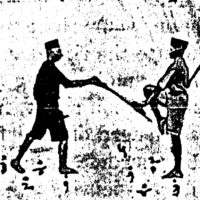
Any other methods of “combat” movement are the result of either a creative approach, not burdened by the need for the practical use of edged weapons on the battlefield, or the fading and loss of a once existing tradition, or a product of modern martial arts of the late 19th-20th centuries. You can only stand in front of one opponent, but even modern boxing shows that this is a bad idea. Against one opponent, as in boxing, you can “shuffle” along one axis. But if add a second enemy to the side, on the right or left side, then it will no longer be possible to “shuffle” along two axes at the same time. And if you add to this the distance for a bladed weapon and the corresponding amplitude for the “shuffle”, then the movements that you will inevitably make will turn out to be suspiciously similar to one of the variants of the Indian pentra, executed in a good or bad manner.
Pentra is not an abstract, theoretical movement or just exercise for pupil. This is not a magic square, image or sacred letter, as is now claimed in modern martial arts. Pentra is a universal method of movement, implemented both in the basic version and in more complex ones.
Relaxed wrists
You will not be able to use force and put it into your movements in attack or defense if you are used to spinning your weapon quickly. Moreover, spinning a weapon at speed using the wrist joint as the center of rotation is not only useless, but also detrimental to both weapon handling skills and the joint itself. To quickly rotate light objects, you need loose, not fixed wrists. If you take a heavy weapon in a hand that is accustomed to relaxation, you will eventually damage not only your wrist, but also other joints and tendons of the arm. On the contrary, if you take even a thin stick, but with a firm “close” Indian grip, as you should hold any Indian weapon, you will no longer be able to rotate it so quickly, because it will be firmly connected to the whole body, including the legs. It is no coincidence that the main exercise of the Indian swordsmen was exercises with clubs, necessary to strengthen, or rather, secure the joints. The laudatory epithet of the Indian warrior of antiquity was “mighty-armed warrior”.
No force is used
Movements without applying force are similar to idling in neutral gear. Your movements must be structured in such a way that you can put force into each of them. Accordingly, at every moment of time, your body should be like a strong frame, like a construction formwork, into which you can pour conditional “concrete”, filling it with energy and strength, but at the same time so that this frame does not fall apart. If you use one framework and one method while practicing with weapon in the air, and then suddenly use a different frame or method to hit not in the air, it means you are learning two different arts.
Lack of control over the edge of talwar/spear/dagger blades
Your weapon is a talwar. And the weapon of the talwar itself is its edge. It is with the blade that you attack the target and it is through the blade that you apply force. You attack the target with an edge and apply force by means of the edge. If you rotate the talwar in the air a lot, you will quickly forget how to hold the blade straight and make an Indian drawing blow, even if you knew how. Previously, in India, when training warriors, it was generally forbidden to wave a saber in the air without counter resistance. It is for this reason that in unarmed Indian martial arts we do not hit the air with fists, elbows, knees or feet, but put force into a balancing movement — put other hand under attack. Even the basic trajectory of rotation, which one begins to master with a short stick and then with a talwar, does not mean an uncontrolled position of the weapon in the air, but always involves drawing the edge. In Indian art, even a stick has two clearly distinguishable sides: supposed “edge” and “back” and then more so talwar or spear. If, when using a saber or spear, your technique does not involve or provide for control of the blade and does not teach you to distinguish between two or four sides of your weapon (one or two edges of the blade and its two flat), then this means that the connection with the practical use of this weapon was lost.
Unfortunately, all of the above reasons give rise to each other, strengthen and at the same time mutually mask their destructive effects. Thus, using the lightest possible weapon avoids the need to use force due to the lack of inertia of the weapon and the need to balance it. The absence of the need to apply force allows you not to move and just stand in one place or jump on two legs. The lack of movement is compensated by the high rotation speed of the weapon instead of real dynamics. The high speed of rotation of the weapon does not require body preparation and strengthening of joints. To compensate for the lack of special preparation of the body and joints, the lightest weapons or training equipment are used, which greatly simplifies training tasks. It is a vicious circle. Exercises performed in this way have no practical meaning and no further development. This is a dead end and you will have to do the same exercises for the rest of your life or eventually stop doing it due to lack of interest and motivation.
The use of thin and light bamboo sticks instead of heavy staffs, which in historical reality were also bound with iron. Chakars made of plastic are as light as possible, they can be rotated effectively and quickly without any problems, they are equipped with a special mesh that prevents tangling, and even plastic weights that are safe for the owner if the item is used incorrectly. A pata-sword with a very flexible blade for effectively cutting a lime fruit lying on the ground (it is clear that with such a blade it is enough to simply hit the ground, and the flexible blade itself will take the necessary angle and move along the surface). Using a simple stick as a spear but without a spearhead, which changes the balance of the object and does not require additional effort, allowing you to simply imitate the technique.

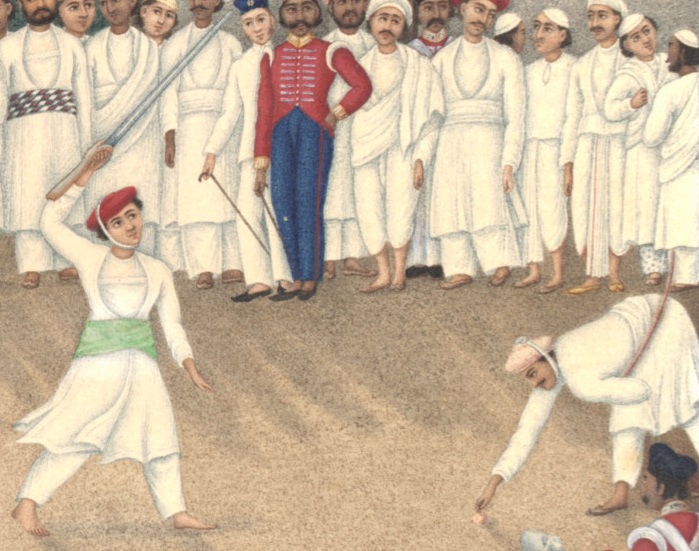
I don’t see a pata-sword with a very flexible blade here.
Martial art are not a collection of tricks or cunning “deadly” blows. Martial art is a prepared body, a body as a weapon. This is power, power, which is the multiplication of force and speed. You can apply weak force at very high speed. Or use very high force at low speed. But this will not be a martial art. Martial art is about using the maximum possible force at the maximum possible speed. Naturally, they will limit each other. But the point of training is to constantly increase this limit of the strength-to-speed ratio. If this does not happen during your training and your «power» does not increase, then you will have to rely either on super speed that will suddenly «appear» in an extreme situation, or on an unknown force that will suddenly knock your opponent down. In this case, as an alternative to martial arts, it is better to choose sports and modern martial arts, in which the lack of growth in force and speed in the training process will be much more difficult to hide.
For this reason, it is reckless to prioritize technique and its development the main goal of training. Technique is only a tool for achieving the required speed and force indicators, just a design or a construction formwork filled with content. Without force and speed, technique is only useful for demonstrations and shows.
The force of a blow, unless you hit the target while jumping or just using your body weight, depends on your ability to create a rigid frame, that provides a connection between the weapon, the hand holding the weapon and the foot stands firmly on the ground and pushes off from it. Because you need to move freely, your legs move and feet step.
It may seem strange to mention Miyamoto Musashi here, but he was a practitioner, and his art was historical, based not only on real fights, but also on participation in at least one mass battle — “I move in fight the same way I walk down the street, alternating my legs».
In this case, every step and each position should create a rigid structure. Accordingly, the speed at which you can apply maximum force depends on the speed at which you can step simultaneously creating the structure. In this case, loss of balance, equilibrium or uncompensated inertial movement will mean “breakdown” of your structure, collapse of the frame and destruction of the formwork — the force did not go into the hand and weapon, but simply splashed out.
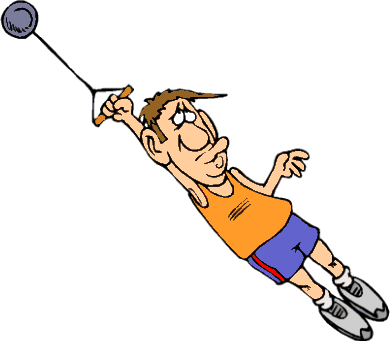
Stages of correct practice (this does not mean the sequence of their development, but the general orientation).
1. It is necessary to synchronize the movement of the arms with the steps. Actions with the hands should fall in the same moment when the foot is placed on the ground. You need to connect the top to the bottom, align vertically. This will be a minimal but coordinated movement of the entire body, giving force to the blow. At this stage, you have begun to control your body.
2. Now let us talk about the horizontal. In Indian fencing, the second (left) hand does not simply additionally hold the main weapon or passively hold the shield. Also it does not perform any decorative function. The second hand performs active actions as the main hand. Your arms, with or without a weapon, must be able to move independently of each other, and we are not talking about synchronized or reverse movements. You can only do it, you cannot think about it. If you think about how to act with both hands separately, independently, simultaneously and each in its own way, you will not be able to continue moving, you will immediately stop. You will have either to stop your body or stop your mind. This is already meditation in motion. You began to take control of your consciousness.
Now, having a body and consciousness, you can move, step and perform actions at any time with any hand — one or two at the same time. Your body now consists of connected arms and legs. In the case of weapons, the arms are the branches and the legs are the roots. Branches in the sky, roots on the ground. You have connected heaven and earth. You are the connector, the conductor, the pillar, the altar. You are almost a creator.
3. In the first stage, the achievement was that you were able to combine main movements of the arms with the additional actions of the legs (steps) and began to move your body as one unit. But now the movements of the arms and legs need to be separated, the movements of the arms should be separated from the movements of the legs and the legs should be made the main ones. You just walk as you want, wherever you want, in any direction, without thinking about the movements of your hands. But at the same time, your blow or cut will definitely fall on the step with your left or right foot, and not between them, because you have already mastered the first stage. You need to learn to walk freely and at the same time, at every step, you are able to put force into the blow, without specifically choosing the moment for this. As a result, you don’t think about how and when to strike or how and how to defend yourself, you simply move freely and can take the necessary actions at any time, because at the previous stage you learned to use your hands without thinking about it. Your attack and your strike will become your step. The step becomes your weapon.
Pentra is three main steps, a universal method of movement, implemented both in the basic version and in the more complex version — in the swastika. The swastika is a pentra on four sides. After conquering the four sides, the «four great kings», you can move as you please. You have measured the space and have almost subjugated it to yourself.
4. When you have learned to walk freely in any direction, regardless of actions with your arms, you need to forget about your legs and steps (you already forgot about your arms in the previous stages) and focus only on your weapon. Your body, movements and consciousness are just a stand for your weapon.
You no longer think about arms, legs, movements, directions, which way to go, or even the pentra and swastika. You yourself no longer exist, you have become your weapon, and it has become you. The weapon, that acting on its own. The weapon, that connected with heaven and earth. The weapon, that controls four directions and space. Now you are a destroyer.



